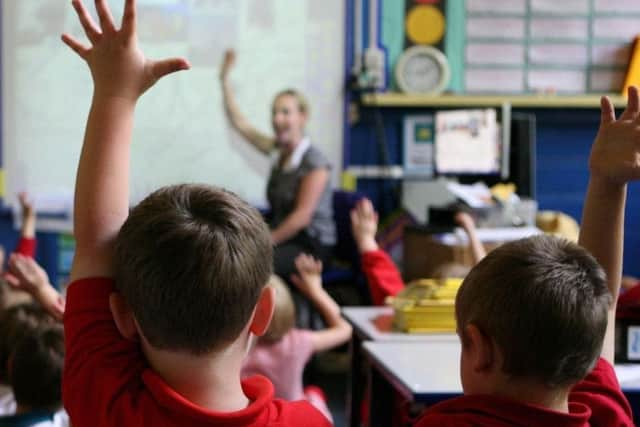6,700 disruptive children excluded from Lancashire's schools: what are teachers doing to tackle the problem?


According to latest figures, both the number of permanent and fixed term exclusions are on the rise in the county’s schools.
More than 300 pupils were told to find new schools in 2015/16 with persistent disruptive behaviour the most frequent discipline issue.
Advertisement
Hide AdAdvertisement
Hide AdA total of 21 youngsters were expelled for sexual offences in schools and a further 69 were excluded for racist abuse. More than 80 were kicked out after committing violent attacks against adults and other children.


But education leaders insist the figures should be viewed in perspective.
The Department for Education statistics, collated by the Lancashire Post, show 305 primary, secondary and special school students were permanently excluded in 2015/16, compared with 150 in 2011/12.
The number of fixed-term exclusions also increased from 5,400 to 6,765.
Advertisement
Hide AdAdvertisement
Hide AdTaking into account rising pupil numbers, the per pupil percentage rate saw a small rise from 0.10 per cent to 0.18 (permanent) and 3.33 to 4.05 per cent (fixed-term).


Both County Hall officials and senior teachers say although the rise should be taken seriously, it is not out of context amid a rising student population.
And they have given backing to primary and secondary teachers to take hardline disciplinary steps if the situation requires.
County Coun Susie Charles, cabinet member for children and schools (inset), said: “In common with the rest of the country, Lancashire has seen a small increase in exclusions, which we take seriously, although more recent figures suggest a drop in primary age permanent exclusions.
Advertisement
Hide AdAdvertisement
Hide Ad“It is important to keep this in perspective; we have more than 167,000 children in around 600 schools, 92 per cent of which are rated as good or outstanding.
“And in terms of the North West average, we have a slightly higher rate of permanent exclusions, and a slightly lower rate of fixed term exclusions.
“Reasons for exclusions can be complex and it is difficult to point to any one reason – the school population has increased during this period and the trend across the country has been towards greater use of exclusions.”
In 2015/16, the latest academic year covered in the data for state-funded schools, persistent disruptive behaviour was the most frequent reason for both permanent (96) and fixed-term (1,626) punishments.
Advertisement
Hide AdAdvertisement
Hide AdThe level of physical assaults, against both fellow students or staff, along with drug and alcohol misuse as reasons for exclusion appear to have maintained a steady rate since 2011.
In relation to the rise in persistent disruptive behaviour, Stephen Cox, headteacher of Ribblesdale High School, said teachers must balance their responsibility to the majority - who have the right to a safe and good education - with the “consequences of exclusion on the minority.”
He said: “Headteachers must clearly have the right to exclude if other pupils’ learning is being seriously and repeatedly compromised due to the behaviour of an individual.”
And schools do “everything possible to keep pupils in school,” county hall added.
Advertisement
Hide AdAdvertisement
Hide AdCounty Coun Charles said: “Decisions to exclude pupils are made by individual headteachers and only taken as a last resort.
“Schools do everything possible to keep pupils in school, and work with parents, carers and a range of external agencies to do this.
“We provide expert advisers and consultants to support schools, and recently ran a pilot support programme for primary schools in West Lancashire, which saw no permanent exclusions in 2016/17.
“Importantly, although we firmly believe that exclusion should only be used as a last resort, we fully support the right of headteachers to use all of the powers at their disposal to maintain and improve discipline in their schools. Headteachers have to try to protect the educational opportunities of all their pupils, which may be affected by the poor behaviour of other children.”
The West Lancs model
West Lancashire Primary Intervention Model:
Advertisement
Hide AdAdvertisement
Hide AdThe West Lancashire pilot was developed by Lancashire County Council in partnership with primary schools in West Lancashire and the School Forum.
The district schools taking part have access to local specialist advice and guidance to support them in cases when a pupils is struggling in school and may be at risk of exclusion.
Support is staged and the focus is on outreach support delivered in the school, either working with individual pupils, groups or providing staff training.
There are also a small number of in house places available for more intensive support programmes out of the pupil’s usual school. The aim is for the pupil to return to their usual school on completion of the intervention programme.
Advertisement
Hide AdAdvertisement
Hide AdThe schools all committed not to permanently exclude. Although, legally, the schools taking part in the pilot are able to permanently exclude, to date there have been no permanent exclusions in the district, and we are now in the second school year of the pilot.
They are trying to replicate this model in other areas of Lancashire.
What do headteachers say?
Stephen Cox is the head of the Secondary Headteacher Executive Committee and headteacher of Ribblesdale High School.
He said: “Whilst there have been small increases in pupils being excluded at both a regional and national level, my experience is that there is no overriding reason behind this in Lancashire. The only area which seems to have changed substantially is the increase in the numbers of young people being permanently excluded for persistent disruptive behaviour.
Advertisement
Hide AdAdvertisement
Hide Ad“Along with my headteacher colleagues, we will only ever use such sanctions as a last resort and always with a heavy heart, once all other options and support have been exhausted.
“However, we have to balance the right to a safe and good education for the majority of young people with the consequences of exclusion on the minority. Comments from other headteachers cite a loss of funding for key support services as a contributory factor to some increase in exclusions but clearly, this is premise, which is very difficult to evidence.”
Facts and figures
School and incident type: 2015/16 - 2011/12
Permanent exclusions, state-funded Primary Schools: 78 - 24
Fixed-period exclusions, SF Primary Schools: 1,007 - 552
Permanent exclusions, SF Secondary Schools: 222 - 125
Fixed-period exclusions, SF Secondary Schools: 5,357 - 4,481
Permanent exclusions, SF Special Schools: 5 - 5
Fixed-period exclusions, SF Special Schools: 401 - 369
Permanent exclusions, SF All schools: 305 - 150
Fixed-period exclusions, SF All schools: 6,765 - 5,400
Reasons
Physical assault against a pupil - permanent exclusions: 31 - 21
Physical assaults against adult: 56 - 17
Drugs and alcohol: 21 - 15
Persistent disruptive behaviour: 96 - 50
Advertisement
Hide AdAdvertisement
Hide AdPhysical assault against a pupil - fixed-term exclusions: 1,100 - 977
Physical assaults against adult: 411 - 267
Drugs and alcohol: 192 - 131
Persistent disruptive behaviour: 1,626 - 1,052
Sexual misconduct: 21 - 30
Racist abuse: 69 - 75